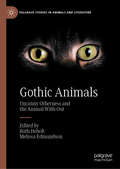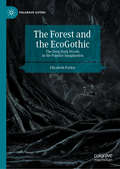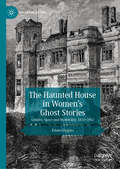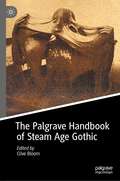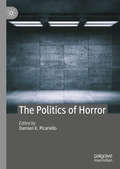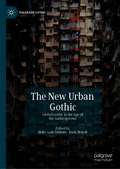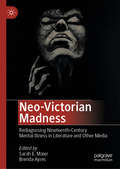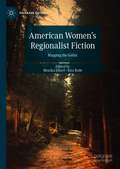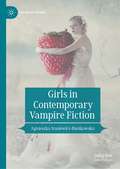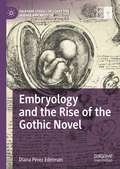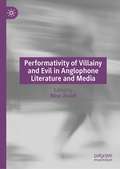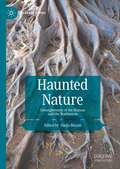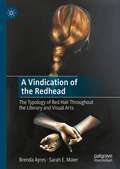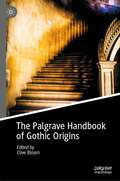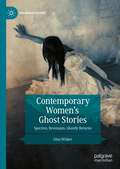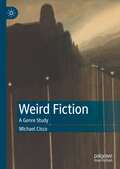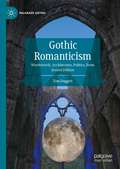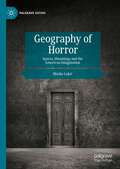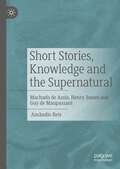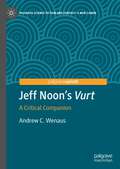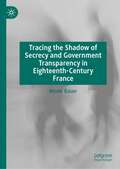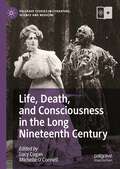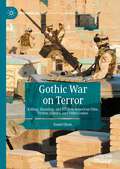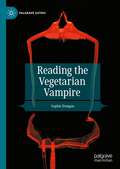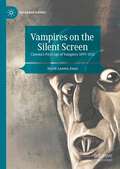- Table View
- List View
Gothic Animals: Uncanny Otherness and the Animal With-Out (Palgrave Studies in Animals and Literature)
by Melissa Edmundson Ruth HeholtThis book begins with the assumption that the presence of non-human creatures causes an always-already uncanny rift in human assumptions about reality. Exploring the dark side of animal nature and the ‘otherness’ of animals as viewed by humans, and employing cutting-edge theory on non-human animals, eco-criticism, literary and cultural theory, this book takes the Gothic genre into new territory. After the dissemination of Darwin’s theories of evolution, nineteenth-century fiction quickly picked up on the idea of the ‘animal within’. Here, the fear explored was of an unruly, defiant, degenerate and entirely amoral animality lying (mostly) dormant within all of us. However, non-humans and humans have other sorts of encounters, too, and even before Darwin, humans have often had an uneasy relationship with animals, which, as Donna Haraway puts it, have a way of ‘looking back’ at us. In this book, the focus is not on the ‘animal within’ but rather on the animal ‘with-out’: other and entirely incomprehensible.
The Forest and the EcoGothic: The Deep Dark Woods in the Popular Imagination (Palgrave Gothic)
by Elizabeth ParkerThis book offers the first full length study on the pervasive archetype of The Gothic Forest in Western culture. The idea of the forest as deep, dark, and dangerous has an extensive history and continues to resonate throughout contemporary popular culture. The Forest and the EcoGothic examines both why we fear the forest and how exactly these fears manifest in our stories. It draws on and furthers the nascent field of the ecoGothic, which seeks to explore the intersections between ecocriticism and Gothic studies. In the age of the Anthropocene, this work importantly interrogates our relationship to and understandings of the more-than-human world. This work introduces the trope of the Gothic forest, as well as important critical contexts for its discussion, and examines the three main ways in which this trope manifests: as a living, animated threat; as a traditional habitat for monsters; and as a dangerous site for human settlement. This book will appeal to students and scholars with interests in horror and the Gothic, ecohorror and the ecoGothic, environmentalism, ecocriticism, and popular culture more broadly. The accessibility of the subject of ‘The Deep Dark Woods’, coupled with increasingly mainstream interests in interactions between humanity and nature, means this work will also be of keen interest to the general public.
The Haunted House in Women’s Ghost Stories: Gender, Space and Modernity, 1850–1945 (Palgrave Gothic)
by Emma LigginsThis book explores Victorian and modernist haunted houses in female-authored ghost stories as representations of the architectural uncanny. It reconsiders the gendering of the supernatural in terms of unease, denial, disorientation, confinement and claustrophobia within domestic space. Drawing on spatial theory by Gaston Bachelard, Henri Lefebvre and Elizabeth Grosz, it analyses the reoccupation and appropriation of space by ghosts, women and servants as a means of addressing the opposition between the past and modernity. The chapters consider a range of haunted spaces, including ancestral mansions, ghostly gardens, suburban villas, Italian churches and houses subject to demolition and ruin. The ghost stories are read in the light of women’s non-fictional writing on architecture, travel, interior design, sacred space, technology, the ideal home and the servant problem. Women writers discussed include Elizabeth Gaskell, Margaret Oliphant, Vernon Lee, Edith Wharton, May Sinclair and Elizabeth Bowen. This book will appeal to students and researchers in the ghost story, Female Gothic and Victorian and modernist women’s writing, as well as general readers with an interest in the supernatural.
The Palgrave Handbook of Steam Age Gothic
by Clive BloomBy the early 1830s the old school of Gothic literature was exhausted. Late Romanticism, emphasising as it did the uncertainties of personality and imagination, gave it a new lease of life. Gothic—the literature of disturbance and uncertainty—now produced works that reflected domestic fears, sexual crimes, drug filled hallucinations, the terrible secrets of middle class marriage, imperial horror at alien invasion, occult demonism and the insanity of psychopaths. It was from the 1830s onwards that the old gothic castle gave way to the country house drawing room, the dungeon was displaced by the sewers of the city and the villains of early novels became the familiar figures of Dr Jekyll and Mr Hyde, Dracula, Dorian Grey and Jack the Ripper. After the death of Prince Albert (1861), the Gothic became darker, more morbid, obsessed with demonic lovers, blood sucking ghouls, blood stained murderers and deranged doctors. Whilst the gothic architecture of the Houses of Parliament and the new Puginesque churches upheld a Victorian ideal of sobriety, Christianity and imperial destiny, Gothic literature filed these new spaces with a dread that spread like a plague to America, France, Germany and even Russia. From 1830 to 1914, the period covered by this volume, we saw the emergence of the greats of Gothic literature and the supernatural from Edgar Allan Poe to Emily Bronte, from Sheridan Le Fanu to Bram Stoker and Robert Louis Stevenson. Contributors also examine the fin-de-siècle dreamers of decadence such as Arthur Machen, M P Shiel and Vernon Lee and their obsession with the occult, folklore, spiritualism, revenants, ghostly apparitions and cosmic annihilation. This volume explores the period through the prism of architectural history, urban studies, feminism, 'hauntology' and much more. 'Horror', as Poe teaches us, 'is the soul of the plot'.
The Politics of Horror
by Damien K. PicarielloThe Politics of Horror features contributions from scholars in a variety of fields—political science, English, communication studies, and others—that explore the connections between horror and politics. How might resources drawn from the study of politics inform our readings of, and conversations about, horror? In what ways might horror provide a useful lens through which to consider enduring questions in politics and political thought? And what insights might be drawn from horror as we consider contemporary political issues? In turning to horror, the contributors to this volume offer fresh provocations to inform a broad range of discussions of politics.
The New Urban Gothic: Global Gothic in the Age of the Anthropocene (Palgrave Gothic)
by Ruth Heholt Holly-Gale MilletteThis collection explores global dystopic, grotesque and retold narratives of degeneration, ecological and economic ruin, dystopia, and inequality in contemporary fictions set in the urban space. Divided into three sections—Identities and Histories, Ruin and Residue, and Global Gothic—The New Urban Gothic explores our anxieties and preoccupation with social inequalities, precarity and the peripheral that are found in so many new fictions across various media. Focusing on non-canonical Gothic global cities, this distinctive collection discusses urban centres in England’s Black Country, Moscow, Detroit, Seoul, Hong Kong, Bangkok, Singapore, Dehli, Srinigar, Shanghai and Barcelona as well as cities of the imaginary, the digital and the animated. This book will appeal to anyone interested in the intersections of time, place, space and media in contemporary Gothic Studies. The New Urban Gothic casts reflections and shadows on the age of the Anthropocene.
Neo-Victorian Madness: Rediagnosing Nineteenth-Century Mental Illness in Literature and Other Media
by Sarah E. Maier Brenda AyresNeo-Victorian Madness: Rediagnosing Nineteenth-Century Mental Illness in Literature and Other Media investigates contemporary fiction, cinema and television shows set in the Victorian period that depict mad murderers, lunatic doctors, social dis/ease and madhouses as if many Victorians were “mad.” Such portraits demand a “rediagnosing” of mental illness that was often reduced to only female hysteria or a general malaise in nineteenth-century renditions. This collection of essays explores questions of neo-Victorian representations of moral insanity, mental illness, disturbed psyches or non-normative imaginings as well as considers the important issues of legal righteousness, social responsibility or methods of restraint and corrupt incarcerations. The chapters investigate the self-conscious re-visions, legacies and lessons of nineteenth-century discourses of madness and/or those persons presumed mad rediagnosed by present-day (neo-Victorian) representations informed by post-nineteenth-century psychological insights.
American Women's Regionalist Fiction: Mapping the Gothic (Palgrave Gothic)
by Monika Elbert Rita BodeAmerican Women’s Regionalist Fiction: Mapping the Gothic seeks to redress the monolithic vision of American Gothic by analyzing the various sectional or regional attempts to Gothicize what is most claustrophobic or peculiar about local history. Since women writers were often relegated to inferior status, it is especially compelling to look at women from the Gothic perspective. The regionalist Gothic develops along the line of difference and not unity—thus emphasizing regional peculiarities or a sense of superiority in terms of regional history, natural landscapes, immigrant customs, folk tales, or idiosyncratic ways. The essays study the uncanny or the haunting quality of “the commonplace,” as Hawthorne would have it in his introduction to The House of the Seven Gables, in regionalist Gothic fiction by a wide range of women writers between ca. 1850 and 1930. This collection seeks to examine how/if the regionalist perspective is small, limited, and stultifying and leads to Gothic moments, or whether the intersection between local and national leads to a clash that is jarring and Gothic in nature.
Girls in Contemporary Vampire Fiction (Palgrave Gothic)
by Agnieszka Stasiewicz-BieńkowskaThis book explores the narratives of girlhood in contemporary YA vampire fiction, bringing into the spotlight the genre’s radical, ambivalent, and contradictory visions of young femininity. Agnieszka Stasiewicz-Bieńkowska considers less-explored popular vampire series for girls, particularly those by P.C. and Kristin Cast and Richelle Mead, tracing the ways in which they engage in larger cultural conversations on girlhood in the Western world. Mapping the interactions between girl and vampire corporealities, delving into the unconventional tales of vampire romance and girl sexual expressions, examining the narratives of women and violence, and venturing into the uncanny vampire classroom to unmask its critique of present-day schooling, the volume offers a new perspective on the vampire genre and an engaging insight into the complexities of growing up a girl.
Embryology and the Rise of the Gothic Novel (Palgrave Studies in Literature, Science and Medicine)
by Diana Pérez EdelmanThis book argues that embryology and the reproductive sciences played a key role in the rise of the Gothic novel in the eighteenth and nineteenth centuries. Diana Pérez Edelman dissects Horace Walpole’s use of embryological concepts in the development of his Gothic imagination and provides an overview of the conflict between preformation and epigenesis in the scientific community. The book then explores the ways in which Gothic literature can be read as epigenetic in its focus on internally sourced modes of identity, monstrosity, and endless narration. The chapters analyze Horace Walpole’s The Castle of Otranto; Ann Radcliffe’s A Sicilian Romance, The Italian, and The Mysteries of Udolpho; Mary Shelley’s Frankenstein; Charles Robert Maturin’s Melmoth the Wanderer; and James Hogg’s Confessions of a Justified Sinner, arguing that these touchstones of the Gothic register why the Gothic emerged at that time and why it continues today: the mysteries of reproduction remain unsolved.
Performativity of Villainy and Evil in Anglophone Literature and Media
by Nizar ZouidiPerformativity of Villainy and Evil in Anglophone Literature and Media studies the performative nature of evil characters, acts and emotions across intersecting genres, disciplines and historical eras. This collection brings together scholars and artists with different institutional standings, cultural backgrounds and (inter)disciplinary interests with the aim of energizing the ongoing discussion of the generic and thematic issues related to the representation of villainy and evil in literature and media. The volume covers medieval literature to contemporary literature and also examines important aspects of evil in literature such as social and political identity, the gothic and systemic evil practices. In addition to literature, the book considers examples of villainy in film, TV and media, revealing that performance, performative control and maneuverability are the common characteristics of villains across the different literary and filmic genres and eras studied in the volume.
Haunted Nature: Entanglements of the Human and the Nonhuman (Palgrave Gothic)
by Sladja BlazanThis volume is a study of human entanglements with Nature as seen through the mode of haunting. As an interruption of the present by the past, haunting can express contemporary anxieties concerning our involvement in the transformation of natural environments and their ecosystems, and our complicity in their collapse. It can also express a much-needed sense of continuity and relationality. The complexity of the question—who and what gets to be called human with respect to the nonhuman—is reflected in these collected chapters, which, in their analysis of cinematic and literary representations of sentient Nature within the traditional gothic trope of haunting, bring together history, race, postcolonialism, and feminism with ecocriticism and media studies. Given the growing demand for narratives expressing our troubled relationship with Nature, it is imperative to analyze this contested ground.
A Vindication of the Redhead: The Typology of Red Hair Throughout the Literary and Visual Arts
by Brenda Ayres Sarah E. MaierA Vindication of the Redhead investigates red hair in literature, art, television, and film throughout Eastern and Western cultures. This study examines red hair as a signifier, perpetuated through stereotypes, myths, legends, and literary and visual representations. Brenda Ayres and Sarah E. Maier provide a history of attitudes held by hegemonic populations toward red-haired individuals, groups, and genders from antiquity to the present. Ayres and Maier explore such diverse topics as Judeo-Christian narratives of red hair, redheads in Pre-Raphaelite paintings, red hair and gender identity, famous literary redheads such as Anne of Green Gables and Pippi Longstocking, contemporary and Neo-Victorian representations of redheads from the Black Widow to The Girl with the Dragon Tattoo, and more. This book illuminates the symbolic significance and related ideologies of red hair constructed in mythic, religious, literary, and visual cultural discourse.
The Palgrave Handbook of Gothic Origins
by Clive BloomThis handbook provides a comprehensive overview of research on the Gothic Revival. The Gothic Revival was based on emotion rather than reason and when Horace Walpole created Strawberry Hill House, a gleaming white castle on the banks of the Thames, he had to create new words to describe the experience of gothic lifestyle. Nevertheless, Walpole’s house produced nightmares and his book The Castle of Otranto was the first truly gothic novel, with supernatural, sensational and Shakespearean elements challenging the emergent fiction of social relationships. The novel’s themes of violence, tragedy, death, imprisonment, castle battlements, dungeons, fair maidens, secrets, ghosts and prophecies led to a new genre encompassing prose, theatre, poetry and painting, whilst opening up a whole world of imagination for entrepreneurial female writers such as Mary Shelley, Joanna Baillie and Ann Radcliffe, whose immensely popular books led to the intense inner landscapes of the Bronte sisters. Matthew Lewis’s The Monk created a new gothic: atheistic, decadent, perverse, necrophilic and hellish. The social upheaval of the French Revolution and the emergence of the Romantic movement with its more intense (and often) atheistic self-absorption led the gothic into darker corners of human experience with a greater emphasis on the inner life, hallucination, delusion, drug addiction, mental instability, perversion and death and the emerging science of psychology. The intensity of the German experience led to an emphasis on doubles and schizophrenic behaviour, ghosts, spirits, mesmerism, the occult and hell. This volume charts the origins of this major shift in social perceptions and completes a trilogy of Palgrave Handbooks on the Gothic—combined they provide an exhaustive survey of current research in Gothic studies, a go-to for students and researchers alike.
Contemporary Women’s Ghost Stories: Spectres, Revenants, Ghostly Returns (Palgrave Gothic)
by Gina WiskerThis book offers new insights on socially and culturally engaged Gothic ghost stories by twentieth century and contemporary female writers; including Shirley Jackson, Angela Carter, Toni Morrison, Ali Smith, Susan Hill, Catherine Lim, Kate Mosse, Daphne du Maurier, Helen Dunmore, Michele Roberts, and Zheng Cho. Through the ghostly body, possessions and visitations, women’s ghost stories expose links between the political and personal, genocides and domestic tyrannies, providing unceasing reminders of violence and violations. Women, like ghosts, have historically lurked in the background, incarcerated in domestic spaces and roles by familial and hereditary norms. They have been disenfranchised legally and politically, sold on dreams of romance and domesticity. Like unquiet spirits that cannot be silenced, women’s ghost stories speak the unspeakable, revealing these contradictions and oppressions. Wisker’s book demonstrates that in terms of women’s ghost stories, there is much to point the spectral finger at and much to speak out about.
Weird Fiction: A Genre Study
by Michael CiscoWeird Fiction: A Genre Study presents a comprehensive, contemporary analysis of the genre of weird fiction by identifying the concepts that influence and produce it. Focusing on the sources of narrative content—how the content is produced and what makes something weird—Michael Cisco engages with theories from Deleuze and Guattari to explain how genres work and to understand the relationship between identity and the ordinary. Cisco also uses these theories to examine the supernatural not merely as a horde of tropes, but as a recognition of the infinity of experience in defiance of limiting norms. The book also traces the sociopolitical implications of weird fiction, studying the differentiation of major and minor literatures. Through an articulated theoretical model and close textual analysis, readers will learn not only what weird fiction is, but how and why it is produced.
Gothic Romanticism: Wordsworth, Architecture, Politics, Form (Palgrave Gothic)
by Tom DuggettGothic Romanticism: Wordsworth, Architecture, Politics, Form offers a revisionist account of both Wordsworth and the politics of antiquarianism in the late eighteenth and early nineteenth centuries. As a historically-driven study that develops a significant critique and revision of genre- and theory-based approaches to the Gothic, it covers many key works by Wordsworth and his fellow “Lake Poets” Samuel Taylor Coleridge and Robert Southey. The second edition incorporates new materials that develop the argument in new directions opened up by changes in the field over the last decade. The book also provides a sustained reflection upon Romantic conservatism, including the political thought and lasting influence of Edmund Burke. New material places the book in wider and longer context of the political and historical forms seen developing in Wordsworth, and proposes Gothic Romanticism as the alternative line of cultural development to Victorian Medievalism.
Geography of Horror: Spaces, Hauntings and the American Imagination (Palgrave Gothic)
by Marko LukićThis book provides a comprehensive reading of a space/place-based experience from the birth of the American horror genre (nineteenth century American Romanticism) to its rise and evolution in the twentieth and twenty-first centuries. Exploring a series of narratives, this study focuses on the role of space and place as key elements for successful articulation of horror. The analysis, therefore, employs different theoretical premises and concepts belonging to human geography, which, while being part of the larger discipline of geography, predominantly directs its attention towards the presence and activities of humans. By connecting such theoretical readings with the continuously evolving American horror genre, this book offers a unique insight into the academically unexplored trans-disciplinary spatially based reading of the genre.
Short Stories, Knowledge and the Supernatural: Machado de Assis, Henry James and Guy de Maupassant
by Amândio ReisThis book proposes a comparative approach to the supernatural short stories of Machado de Assis, Henry James and Guy de Maupassant. It offers an alternative to predominantly novel-centric and Anglo-centric perspectives on literary pre-modernism by investigating a transnational and multilingual connection between genre, theme and theory, i.e., between the modern short story, the supernatural and the problem of knowledge. Incorporating a close analysis of the literary texts into a discussion of their historical context, the book argues that Machado, James and Maupassant explore and reinvent the supernatural short story as a metafictional genre. This modernized and innovative form allows them to challenge the dichotomies and conventions of realist and supernatural fiction, inviting their past and present readers to question common assumptions on reality and literary representation.
Jeff Noon's "Vurt": A Critical Companion (Palgrave Science Fiction and Fantasy: A New Canon)
by Andrew C. WenausThis book offers an examination of Jeff Noon’s iconoclastic debut novel, Vurt (1993). In this first book-length study of the novel, which includes an extended interview with Noon, Wenaus considers how Vurt complicates the process of literary canonization, its constructivist relationship to genre, its violent and oneiric setting of Manchester, its use of the Orphic myth as an archetype for the practice of literary collage and musical remix, and how the structural paradoxes of chaos and fractal geometry inform the novel’s content, form, and theme. Finally, Wenaus makes the case for Vurt’s ongoing relevance in the 21st century, an era increasingly characterized by neuro-totalitarianism, psychopolitics, and digital surveillance. With Vurt, Noon begins his project of rupturing feedback loops of control by breaking narrative habits and embracing the contingent and unpredictable. An inventive, energetic, and heartbreaking novel, Vurt is also an optimistic and heartfelt call for artists to actively create open futures.
Tracing the Shadow of Secrecy and Government Transparency in Eighteenth-Century France
by Nicole BauerThis book traces changing attitudes towards secrecy in eighteenth-century France, and explores the cultural origins of ideas surrounding government transparency. The idea of keeping secrets, both on the part of individuals and on the part of governments, came to be viewed with more suspicion as the century progressed. By the eve of the French Revolution, writers voicing concerns about corruption saw secrecy as part and parcel of despotism, and this shift went hand in hand with the rise of the idea of transparency. The author argues that the emphasis placed on government transparency, especially the mania for transparency that dominated the French Revolution, resulted from the surprising connections and confluence of changing attitudes towards honour, religious movements, rising nationalism, literature, and police practices. Exploring religious ideas that associated secrecy with darkness and wickedness, and proto-nationalist discourse that equated foreignness with secrecy, this book demonstrates how cultural shifts in eighteenth-century France influenced its politics. Covering the period of intense fear during the French Revolution and the paranoia of the Reign of Terror, the book highlights the complex interplay of culture and politics and provides insights into our attitudes towards secrecy today.
Life, Death, and Consciousness in the Long Nineteenth Century (Palgrave Studies in Literature, Science and Medicine)
by Lucy Cogan Michelle O’ConnellThis book explores how the writers, poets, thinkers, historians, scientists, dilettantes and frauds of the long-nineteenth century addressed the “limit cases” regarding human existence that medicine continuously uncovered as it stretched the boundaries of knowledge. These cases cast troubling and distorted shadows on the culture, throwing into relief the values, vested interests, and power relations regarding the construction of embodied life and consciousness that underpinned the understanding of what it was to be alive in the long nineteenth century. Ranging over a period from the mid-eighteenth century through to the first decade of the twentieth century—an era that has been called the ‘Age of Science’—the essays collected here consider the cultural ripple effects of those previously unimaginable revolutions in science and medicine on humanity’s understanding of being.
Gothic War on Terror: Killing, Haunting, and PTSD in American Film, Fiction, Comics, and Video Games (Palgrave Gothic)
by Danel OlsonAfter 9/11, the world felt the “shock and awe” of the War on Terror. But that war also exploded inside novels, films, comics, and gaming. Danel Olson investigates why the paranormal, ghostly, and conspiratorial entered such media between 2002-2022, and how this Gothic presence connects to the most recent theories on PTSD. Set in New York/Gotham, Afghanistan, Iraq, and CIA black sites, the traumatic and weird works interrogated here ask how killing affects the killers. The protagonists probed are artillery, infantry, and armored-cavalry soldiers; military intelligence; the Air Force; counter-terrorism officers of the NYPD, NCIS, FBI, and CIA; and even the ultimate crime-fighting vigilante, Batman.
Reading the Vegetarian Vampire (Palgrave Gothic)
by Sophie DunganThis Pivot traces the rise of the so-called “vegetarian” vampire in popular culture and contemporary vampire fiction, while also exploring how the shift in the diet of (some) vampires, from human to animal or synthetic blood, responds to a growing ecological awareness that is rapidly reshaping our understanding of relations with others species. The book introduces the trope of the vegetarian vampire, as well as important critical contexts for its discussion: the Anthropocene, food studies, and the modern practice, politics and ideologies of vegetarianism. Drawing on references to recent historical contexts and developments in the genre more broadly, the book investigates the vegetarian vampire’s relationship to other more violent and monstrous forms of the vampire in popular twenty-first century horror cinema and television. Texts discussed include Interview with the Vampire, Buffy the Vampire Slayer, Twilight, The Vampire Diaries and True Blood. Reading the Vegetarian Vampire examines a new aspect of contemporary interest in considering vampire fiction.
Vampires on the Silent Screen: Cinema’s First Age of Vampires 1897-1922 (Palgrave Gothic)
by David Annwn JonesThis book is the first study of the vampires in silent cinema, presenting a detailed academic yet accessible discussion of the films themselves and their sources. For the very first time, The Fire Elemental from the Wharton brothers’ The Mysteries of Myra (1916) is identified as cinema’s original vampire, his appearance initiating a rich and variegated period of film production that is currently missing from studies of horror cinema. Exciting and ground-breaking, Vampires on the Silent Screen also discusses Drakula Halála / Dracula’s death (1920), the first ever filmic female vampire in Erich Kober’s Lilith and Ly (1919), and the Dracula lookalike, Count Merlin in Alexander Korda’s Magic (1917) as well as many other productions. A socio-cultural framework with critical highlighting of eco-horror theory is used throughout to draw these unique discoveries together. This project is a must read for any horror enthusiasts out there.
